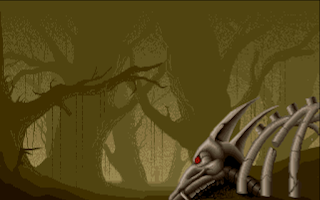 |
| The holy grail for teenage nerds in the 1980s. (image from Pinterest) |
Yet despite the keyboard and floppy drive, the Amiga could never escape its true purpose. There was a lot you could do with the computer, from composing music to producing home videos, but Amiga owners always found themselves returning to its vast library of video games. Amiga games were typically designed in the United Kingdom, where the computer was most popular, and the European influence could plainly be seen in their lavish backgrounds and a quirky sense of humor.
 |
| I've got one of these now! Geez, it took long enough... (image from Amazon) |
Yet even in death, the Amiga remained fascinating to me. I've spent hours playing its games in the WinUAE emulator, discovering everything I missed in the 1980s... as well as a fair share of titles I would have been better off leaving in the past. Even the lousy games have been an education, and here's what I've learned so far about the Amiga experience:
◦ The Amiga was, in its original design, limited to just 32 colors. The more clever developers could squeeze a lot more out of the hardware with a special technique called Hold and Modify, but this was better suited to static images, not animation (and by extension, games). The color palette would get a big boost years later with AGA, a technology which allowed later Amiga systems to display 256 colors out of a selection of... sixteen million? Yeah, I think I could work with that!
 |
| Left: Amiga (32 colors) Right: TurboGrafx-16 (256 colors) |
◦ The Amiga is capable of producing crisp digitized speech and other sound samples... and boy did developers take advantage of it! Sometimes this resulted in powerful soundtracks like the one in Agony, but sometimes you'll wish the designers had shown a little restraint, like when every item you collect in Super Methane Bros. comes with its own wacky noise. There are a lot of items in that game, by the way. I hope you brought just as much patience for stupid sound effects.
 |
| Nope, you're done. Go home. |
◦ Some Amiga games give you music or sound effects, but not both at once. Sometimes you're allowed to choose between the two, but occasionally that choice will be forced on you. Platformers like Oscar and Zool have no background music and feel naggingly incomplete without it. And kind of creepy too, now that I think about it.
◦ The motif for the lion's share of Amiga games (especially Psygnosis games) is "progressive rock album cover come to life." Be prepared to see a lot of surreal landscapes littered with aliens, dragons, and combinations of the two. (Admittedly, there are worse things than having your video game look like a Roger Dean poster.)
 |
| No controller standard means you get to spend some quality time with your old friend, hand- cramping 2600 joystick! |
◦ Originally, Amiga games had to be loaded from a floppy disc. If you have the option- and you almost certainly do if you're playing these games on an emulator- I would suggest using a virtual hard drive instead. You can set one up by using these instructions provided by GBATemp member Dansmell. When you're finished, you can quickly and painlessly access your games from Workbench, a user interface that's the rough Amiga equivalent of Windows. You can even use the hard drive file you made in the recently released UAE4All for the Playstation Vita, making it even more handy.
Oh, I'm not done yet! I'll be reviewing a handful of Amiga games in the second part of this feature, so stay tuned!
(Special thanks to Wikipedia, Old Computers, and Lemon Amiga for providing valuable information for this article.)

No comments:
Post a Comment